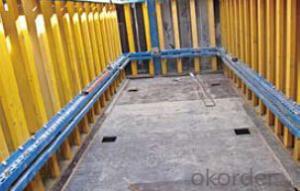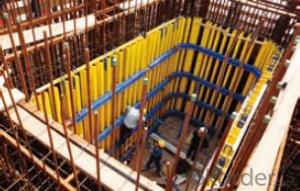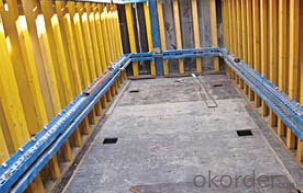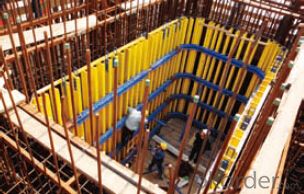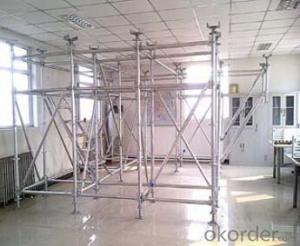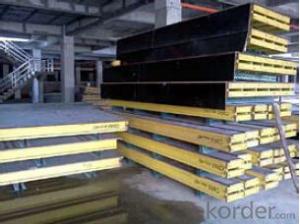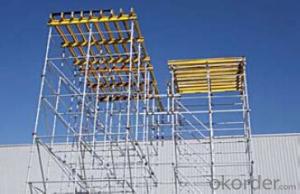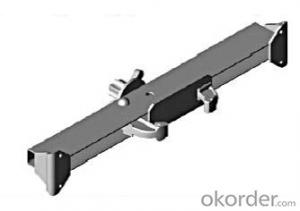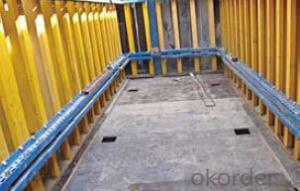Shaft-platform System For Formwork and Scaffolding
- Loading Port:
- Tianjin
- Payment Terms:
- TT OR LC
- Min Order Qty:
- 50 m²
- Supply Capability:
- 1000 m²/month
OKorder Service Pledge
Quality Product, Order Online Tracking, Timely Delivery
OKorder Financial Service
Credit Rating, Credit Services, Credit Purchasing
You Might Also Like
Shaft Platform
As operating platform, the shaft platform is mainly used in the concrete pouring of elevator shaft,
equipment shaft, stair shaft of high-rise building and so on.
Characteristics:
◆ The length of shaft beam is adjustable.
◆ Flexible structure makes lifting easier.
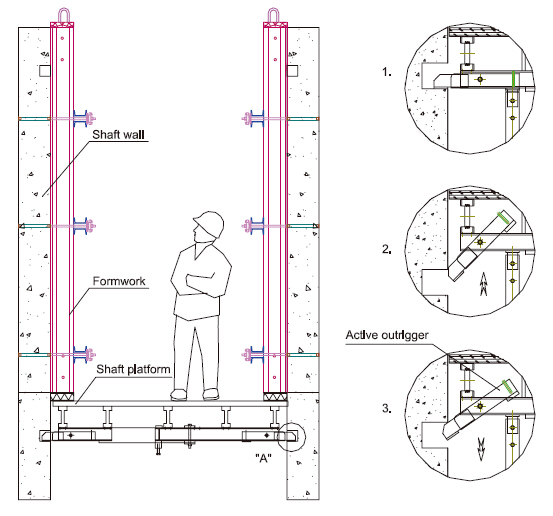
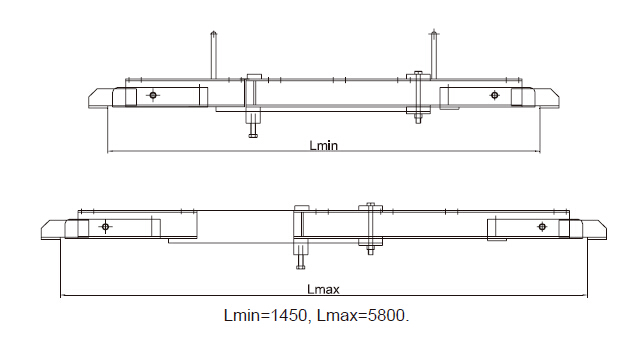
- Q: Can steel formwork be used for curved or complex shapes?
- Indeed, curved or complex shapes can be achieved using steel formwork. Steel, being a resilient and long-lasting material, can effortlessly be manipulated and molded to accommodate diverse designs. Its flexibility allows for the creation of intricate and personalized formwork systems suitable for a vast array of applications, including curved or complex shapes. The robustness and solidity of steel guarantee that the formwork remains steadfast throughout the pouring and setting of concrete, enabling meticulous and precise construction. Furthermore, the reusability of steel formwork proves to be an economical choice for projects necessitating curved or complex shapes.
- Q: Can steel formwork be used for office building construction projects?
- Office building construction projects can indeed utilize steel formwork. This option, known for its versatility and durability in concrete construction, presents numerous advantages. With its exceptional strength and stability, steel formwork can withstand the pressures and loads encountered throughout the construction process. Furthermore, its reusability renders it a cost-effective choice for extensive undertakings such as office buildings. Moreover, the assembly and disassembly of steel formwork are effortless, facilitating swift and efficient construction and enabling faster turnaround times. Overall, steel formwork stands as a fitting choice for office building construction projects due to its robustness, longevity, cost-effectiveness, and efficiency.
- Q: Are there any limitations to using steel formwork?
- Yes, there are some limitations to using steel formwork. Firstly, steel formwork is relatively expensive compared to other types of formwork materials such as wood or plastic. This can make it less cost-effective for smaller projects or projects with a limited budget. Secondly, steel formwork is heavy and requires heavy lifting equipment for installation and removal. This can be a challenge in areas with limited access or where cranes and other heavy machinery may not be readily available. Additionally, steel formwork requires skilled labor for proper installation and dismantling. It is important to have experienced workers who are familiar with the use of steel formwork to ensure the safety and effectiveness of the formwork system. Furthermore, steel formwork is susceptible to corrosion if not properly protected. This can be a concern in environments with high humidity or exposure to moisture, requiring additional maintenance and protective measures. Lastly, steel formwork is not as flexible or adaptable as other types of formwork materials. It may not be suitable for complex or irregular shapes and may require more time and effort to customize for specific project requirements. Overall, while steel formwork offers durability and strength, its limitations in terms of cost, weight, labor requirements, susceptibility to corrosion, and flexibility should be considered when choosing the most appropriate formwork system for a specific construction project.
- Q: What are the different material handling requirements for steel formwork?
- The different material handling requirements for steel formwork involve proper storage, lifting, transportation, and maintenance of the steel components. Steel formwork should be stored in a dry and secure area, away from moisture and exposure to the elements. When lifting, it is essential to use appropriate lifting equipment and follow proper rigging procedures to ensure the safety of workers and prevent damage to the formwork. During transportation, the steel formwork should be securely fastened and protected from any potential impacts or vibrations. Regular maintenance, including cleaning, inspection, and repair, is crucial to ensure the longevity and performance of the steel formwork.
- Q: How does steel formwork handle different concrete air content requirements?
- Steel formwork does not directly handle concrete air content requirements. The air content in concrete is mainly controlled by the mix design and the use of air-entraining agents. Steel formwork, being a rigid and non-porous material, does not have any direct influence on the air content in concrete. However, formwork design and construction practices can indirectly affect the air content by ensuring proper compaction and consolidation of the concrete, which is crucial for achieving the desired air content.
- Q: How does steel formwork affect the overall speed of construction?
- Steel formwork can greatly accelerate the speed of construction due to its durability and reusability. Unlike traditional wooden formwork, steel formwork can withstand multiple uses without being damaged or deformed, allowing for faster assembly and dismantling of formwork systems. Its robustness also enables it to bear heavier loads, reducing the need for additional support structures. Additionally, steel formwork provides a smooth and uniform surface finish, reducing the time required for plastering and other finishing tasks. Overall, the use of steel formwork contributes to increased efficiency, shorter construction cycles, and faster project completion.
- Q: Can steel formwork be used for road construction?
- Yes, steel formwork can be used for road construction. Steel formwork is a popular choice for road construction projects due to its durability, strength, and versatility. It is capable of withstanding heavy loads and pressure, making it suitable for creating sturdy and long-lasting road surfaces. Steel formwork can be easily assembled and disassembled, allowing for efficient construction processes and faster project completion. Additionally, steel formwork can be reused multiple times, making it a cost-effective option for road construction.
- Q: What are the common safety guidelines when working with steel formwork?
- To ensure the well-being of workers and prevent accidents, it is important to adhere to several common safety guidelines when working with steel formwork. These guidelines encompass the following: 1. Utilizing Personal Protective Equipment (PPE): Workers must wear the appropriate PPE, which includes safety helmets, safety glasses, gloves, and steel-toed boots. This will safeguard them against potential hazards such as falling objects and cuts. 2. Emphasizing Training and Competency: Workers should undergo thorough training on the proper usage and handling of steel formwork. They should possess the necessary knowledge and skills to safely perform their assigned tasks. 3. Conducting Inspections: Regular inspections of the steel formwork must be carried out prior to and during its use. The objective is to ensure that it is in good condition and free from defects. Any damaged or faulty parts should be promptly repaired or replaced. 4. Employing Proper Handling Techniques: Due to the weight and unwieldiness of steel formwork, it is imperative to utilize correct lifting techniques and mechanical aids when moving or positioning it. This will prevent musculoskeletal injuries caused by excessive strain or overexertion. 5. Ensuring Secure Installation: The formwork must be securely installed and braced to prevent collapse or displacement during the pouring of concrete. It should be aligned and supported properly to maintain stability throughout the construction process. 6. Implementing Fall Protection: Adequate fall protection measures, such as guardrails or safety harnesses, should be in place when working at heights. Additionally, workers should exercise caution on slippery surfaces and take necessary precautions to prevent slips, trips, and falls. 7. Communicating Hazards: Clear signage and warnings should be prominently displayed to alert workers to potential hazards and provide instructions on safety procedures. Effective communication and coordination among workers are also essential in preventing accidents. 8. Regular Maintenance: Regular maintenance and cleaning of the steel formwork are crucial to remove debris, rust, or other materials that could compromise its integrity. This will contribute to its overall safety and longevity. By adhering to these common safety guidelines, the risk of accidents and injuries can be significantly reduced, ultimately creating a safer work environment for all individuals involved.
- Q: What are the main components of steel formwork?
- The main components of steel formwork are panels, stiffeners, and connecting brackets. Steel formwork panels are typically made of high-quality steel sheets that are rigid and durable. These panels come in various sizes and shapes, such as rectangular, square, or circular, depending on the required shape of the concrete structure. They are designed to withstand the pressure exerted by the concrete during pouring and curing. Stiffeners are used to reinforce the steel formwork panels and enhance their load-bearing capacity. They are usually welded or bolted onto the panels to provide additional strength and stability. Stiffeners are particularly important in large-scale projects or when dealing with heavy concrete loads. Connecting brackets play a vital role in assembling the steel formwork system. They are used to connect the formwork panels together and ensure proper alignment and stability. These brackets are typically made of steel and are designed to securely hold the formwork panels in place. They are easy to install and remove, allowing for efficient and convenient formwork assembly. Overall, steel formwork offers numerous advantages such as high strength, durability, and reusability. Its main components, panels, stiffeners, and connecting brackets, work together to create a robust and reliable system that can withstand the pressure of concrete pouring and provide a smooth and accurate surface finish.
- Q: Can steel formwork be used for complex geometric designs?
- Complex geometric designs can indeed be achieved using steel formwork. Steel, being a versatile material, can be effortlessly shaped and molded into diverse intricate forms, thereby making it well-suited for such designs. By employing steel formwork, construction can be carried out with utmost precision and accuracy, guaranteeing the attainment of the desired shape and dimensions. Moreover, the robustness and longevity of steel render it capable of withstanding the weight and pressure exerted during the pouring of concrete, thus establishing steel formwork as a dependable option for the creation of complex geometric designs in construction endeavors.
Send your message to us
Shaft-platform System For Formwork and Scaffolding
- Loading Port:
- Tianjin
- Payment Terms:
- TT OR LC
- Min Order Qty:
- 50 m²
- Supply Capability:
- 1000 m²/month
OKorder Service Pledge
Quality Product, Order Online Tracking, Timely Delivery
OKorder Financial Service
Credit Rating, Credit Services, Credit Purchasing
Similar products
Hot products
Hot Searches
Related keywords
